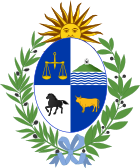H. E. Eduardo Jiménez de Aréchaga was an Uruguayan professor, jurist, and President of the International Court of Justice.

The Uruguayan Air Force is the air service branch of the Armed Forces of Uruguay. Originally created as part of the National Army of Uruguay, the Air Force was established as a separate branch on December 4, 1953. It is the youngest and also the smallest branch of the Armed Forces of Uruguay. In 1977 it was determined that the mission of the Air Force is to conduct strategic and tactical aerospace operations on behalf of the national defense, exercising the sovereignty of the Uruguayan airspace and defending the independence, integrity, constitution and laws of the country. The Air Force must also conduct search and rescue missions and plan, propose, execute and supervise the necessary measures for the development of the aerospace potential, while providing any necessary and possible logistical support during the natural disasters that the country may suffer. Since 1985 this has been always carried out under the command of the President of Uruguay, and according to the Minister of National Defense.

The Political Constitution of Colombia of 1991, is the Constitution of the Republic of Colombia. It was promulgated in Constitutional Gazette number 114 on Thursday, July 4, 1991, and is also known as the Constitution of Human Rights. It replaced the Political Constitution of 1886 and was issued during the presidency of the liberal César Gaviria, with ideas from the also liberal Luis Carlos Galán.

Montevideo is a department (departamento) of Uruguay. It is by far the smallest department in area, but also by far the most populated. Its capital is the city of Montevideo, which is also the national capital. While most of the department is covered by the capital city, there are still smaller towns within its limits.

The Constitution of Uruguay is the supreme law of Uruguay. Its first version was written in 1830 and its last amendment was made in 2004.
Bartolomé Clavero Salvador was a Spanish jurist and historian, specialized in legal history.

The Great Siege of Montevideo, named as Sitio Grande in Uruguayan historiography, was the siege suffered by the city of Montevideo between 1843 and 1851 during the Uruguayan Civil War.

The legal system of Uruguay belongs to the Continental Law tradition.

Daoiz Gerardo Uriarte Araújo is a lawyer, professor and Uruguayan politician member of the moderate sector Vertiente Artiguista, Frente Amplio coalition, the party which ruled Uruguay from 2005 to 2019.

The first Constitution of Uruguay dates back to 1830. Drafted by the Constituent Assembly, summoned in the Church of La Aguada in 1829, it was sworn by the citizens on 18 July 1830.

The judiciary of Uruguay is a branch of the government of Uruguay that interprets and applies the laws of Uruguay, to ensure equal justice under law, and to provide a mechanism for dispute resolution. The legal system of Uruguay is a civil law system, with public law based on the 1967 Constitution, amended in 1989, 1994, 1997, and 2004. The Constitution declares Uruguay to be a democratic republic, and separates the government into three equal branches, executive, legislative and judicial. Private relationships are subject to the Uruguayan Civil Code, originally published in 1868. The Constitution defines the judiciary as a hierarchical system courts, with the highest court being a five-member Supreme Court, who are appointed by the legislative branch of the government, for ten-year terms. The Supreme Court appoints the judges of most of the lower courts. Below the Supreme Court, there are sixteen courts of appeal, each of which has three judges. Seven of the courts of appeal specialize in civil matters, four specialize in criminal matters, three cover labour law, and two focus on family matters. At the lowest tier are justices of the peace and courts of first instance specialized in administrative, civil, criminal, customs, juvenile, and labour cases. Although the hierarchy, all of them are functionally and structurally impartial, that is, the tribunal should not be interested in the object of the particular case, and the higher tribunal does not impose a behaviour nor precedent to the lower ones. There are also separate courts for auditing, elections and the military.
Julio César Lupinacci Gabriel was a Uruguayan diplomat.
The First South American Congress of Private International Law was an international congress on private international law and an ad-hoc codifier forum of international conflict of laws treaties held in Montevideo from 25 August 1888 to 18 February 1889, in which eight treaties and an additional protocol were passed that covered practically all the subjects of conflicts of laws of that time. These were one of the first treaties on conflict of laws to come into force in the world.
Fany Puyesky Mitnik was a lawyer, writer, and dramatist known as "the first feminist" of Uruguay.

The 2019 Uruguayan constitutional referendum, officially referred to as the referendum for constitutional reform on security matters, took place alongside general election of that year, on 27 October 2019, to ask the electorate whether a constitutional reform in public security should be approved. The proposed amendments to the Constitution would create a national guard, forbid early release for some serious crimes, introduce life sentences for crimes of rape, sexual abuse or homicide of minors as well as aggravated homicide of adults, and allow the police to conduct night raids. The referendum resulted in 46.8% of the votes cast in favor of amending the Constitution; however, not reaching the necessary 50%, the amendment was not approved, being rejected by 53.7% of the votes.
Estanislao Valdés Otero is a Uruguayan lawyer, author, and politician.

Felipe Michelini Delle Piane was an Uruguayan lawyer, politician and diplomat, who served in the Chamber of Representatives of Uruguay for the Nuevo Espacio party from 1995 till 2015. He was a member of the Board of Directors of the Trust Fund of the International Criminal Court from 2015 to 2020. He also served as vice-president on the Executive Board of UNESCO from 2005 to 2007.
Gerardo Caetano Hargain is a Uruguayan historian, professor, political scientist, and former association football player.
THe interim governorship of Joaquín Suárez was the pre-Constitution government period of Uruguay which began after his appointment by the Constitutional Assembly as the interim substitute Governor and Captain General from 2nd December until 22nd December 1828 when the elected Governor and Captain General José Rondeau assumed his charge. During the twenty days of this brief period the cessation of all foreign authorities on the territory was ordered and several national symbols were established.
Aeronautical Law Code was a legal code that codified the rules about aeronautical law matters in Uruguay. It was promulgated on 3 December 1942 and came into force on 3 March 1943. It was repealed by the 1974 Aeronautical Code, which superseded it and updated Uruguayan laws on aviation.








